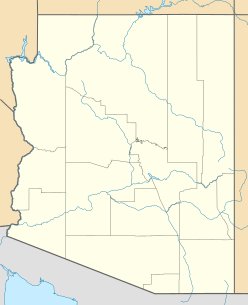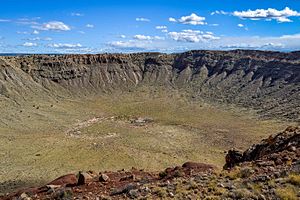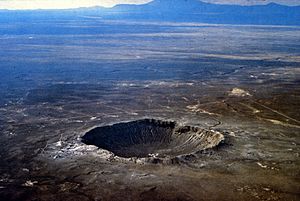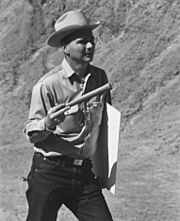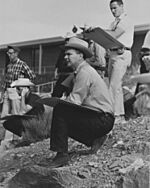Meteor Crater facts for kids
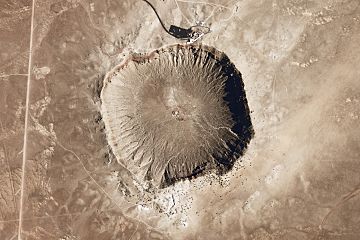
Meteor Crater
|
|
| Impact crater/structure | |
|---|---|
| Confidence | Confirmed |
| Diameter | 0.737 miles (1.186 km) |
| Depth | 560 feet (170 m) |
| Rise | 148 feet (45 m) |
| Impactor diameter | 160 feet (50 m) |
| Age | 50,000 years |
| Exposed | Yes |
| Drilled | Yes |
| Bolide type | Iron meteorite |
| Location | |
| Location | Coconino County |
| Coordinates | 35°01′41″N 111°01′24″W / 35.02806°N 111.02333°W |
| Country | United States |
| State | Arizona |
| Access | Interstate 40 |
| Designated: | November 1967 |
Meteor Crater, also known as Barringer Crater, is a giant hole in the ground made by a meteorite. It's located in the desert of northern Arizona, United States. This amazing crater is about 37 miles (60 km) east of Flagstaff. It's also 18 miles (29 km) west of Winslow.
The crater has had many names over time. Pieces of the meteorite found here are called the Canyon Diablo Meteorite. This name comes from a nearby place called Canyon Diablo.
Meteor Crater is very large. It measures about 0.75 miles (1.2 km) across. It is also about 560 feet (170 m) deep. A rim of rock rises 148 feet (45 m) above the flat land around it. The bottom of the crater is filled with 690–790 feet (210–240 m) of broken rock. Scientists think its slightly square shape comes from natural cracks in the ground.
Even though it's a famous landmark, the Barringer family still owns the crater. They own it through their company, the Barringer Crater Company. Many science groups, like the Lunar and Planetary Institute, say it's the "best-preserved meteorite crater on Earth." It became a National Natural Landmark in November 1967.
Contents
How Meteor Crater Formed

This huge crater was made about 50,000 years ago. This was during the Pleistocene ice age. At that time, the weather in Arizona was much cooler and wetter. The area was a grassy plain with some forests. Large animals like mammoths and giant ground sloths lived there.
The object that made the crater was a nickel-iron meteorite. It was about 160 feet (50 m) wide. Scientists have studied how fast it hit the Earth. They now think it crashed at about 8 miles per second (12.8 km/s). About half of the meteorite turned into gas as it flew through the air.
The impact was incredibly powerful. It was like 10 megatons of TNT exploding. Most of the meteorite turned into vapor when it hit. This is why very few pieces of it were left in the crater.
Since it formed, the crater's rim has lost some height. Natural erosion has worn away about 50–65 feet (15–20 m). The bottom of the crater has also filled in. About 100 feet (30 m) of dirt and lake sediments have collected there. Many craters on Earth have disappeared due to erosion. But Meteor Crater is quite young. Also, Arizona's dry climate has kept it almost the same. This good preservation helped scientists understand that it was made by an impact.
Discovering the Crater's Secret
American settlers first saw Meteor Crater in the 1800s. People gave it many names, like "Coon Mountain" and "Meteor Mountain." At first, many thought it was a volcanic steam explosion. This was because there are many volcanoes in Arizona.
Early Ideas and Investigations
In 1891, a scientist named Albert E. Foote studied rocks from the area. He quickly realized they were meteorites. He led a trip to find more pieces. His team found many samples, some weighing over 600 pounds (270 kg). Foote even found tiny diamonds in the meteorites. His work was the first scientific report about the crater.
Later that year, Grove Karl Gilbert, a chief geologist, studied the crater. He thought it was from a volcanic explosion. Gilbert believed that if a meteorite made it, there should be a lot of meteorite material left. He also thought there would be a strong magnetic signal. But he found neither. So, he concluded it was volcanic. Interestingly, Gilbert was one of the first to suggest that the Moon's craters were also from impacts.
Daniel Barringer's Big Idea
A mining engineer named Daniel M. Barringer had a different idea. He thought a huge iron meteorite had created the crater. At that time, many scientists didn't believe in impact craters. They thought craters on the Moon were volcanic.
Barringer was a successful businessman. He believed the main part of the meteorite was still buried under the crater floor. He didn't know that most of the meteorite would have turned into gas on impact. Barringer started a company to mine the asteroid. He thought it weighed 10 million tons.
He spent 27 years and a lot of money trying to find this buried meteorite. He drilled down 1,375 feet (419 m). But he never found a large deposit.
In 1929, an astronomer named F. R. Moulton studied the impact. He figured out that the meteorite was much smaller, about 300,000 tons. He also concluded that the impact would have vaporized it instantly. Barringer died shortly after Moulton's report came out. By then, many scientists had started to agree that the crater was indeed from an impact.
Harvey Nininger's Discoveries
Harvey Harlow Nininger was a scientist who loved meteorites. In the 1930s, he helped many people get interested in them. He wrote a pamphlet explaining how an asteroid made Meteor Crater. In 1942, Nininger moved his home and museum to a spot near the crater. He called it the "American Meteorite Museum."
Nininger did a lot of research at the crater. He found special rocks called impactite. He also found tiny iron-nickel balls that formed when the asteroid vaporized. His work helped scientists accept that Meteor Crater was made by an asteroid impact.
Nininger wanted the crater to be a national monument. He hoped a public museum could be built there. But the Barringer family, who owned the crater, didn't like his idea. They stopped him from doing more research there. A few years later, the Barringer family built their own private museum on the crater rim.
Eugene Shoemaker's Proof
Eugene Merle Shoemaker continued studying the crater. He made a very important discovery. He found special minerals called coesite and stishovite in the crater. These minerals only form when rocks are hit with extreme force. This kind of force cannot come from volcanoes. It can only come from a huge impact or a nuclear explosion.
In 1960, Shoemaker and Edward C. T. Chao found coesite at Meteor Crater. This was strong proof that the crater was made by an impact. It showed that the impact created incredibly high temperatures and pressures. Shoemaker confirmed that most of the meteorite turned into gas. The pieces of Canyon Diablo meteorite found nearby broke off before or during the crash.
Crater Geology: Flipped Rocks
The impact was so powerful that it flipped the layers of rock around the crater. If you climb the rim from the outside, you see the rock layers in reverse order. The impact turned them upside down for about 0.6–1.2 miles (1–2 km) around the crater's edge.
For example, the Coconino Sandstone is usually at the bottom. But here, it's near the top of the rim. Below it are the Toroweap Formation (limestone), then the Kaibab Formation (dolostone). The Moenkopi Formation (mudstone) is found nearest the outer foot of the rim.
Recent History and Astronaut Training
During the 1960s and 1970s, NASA astronauts trained at Meteor Crater. They practiced there to get ready for the Apollo missions to the Moon. Astronauts still train there today.
In 1964, a small plane crashed inside the crater. Two pilots flew too low and couldn't get enough speed to climb out. The plane stalled and crashed. Both pilots were badly hurt but survived. You can still see a small part of the wreckage today.
Visiting Meteor Crater
Meteor Crater is a very popular place to visit. About 270,000 people come each year. The Barringer Crater Company, owned by the Barringer family, manages it. It's an important place for both education and science.
The Meteor Crater Visitor Center is on the north rim of the crater. It has fun, interactive exhibits. You can learn about meteorites, asteroids, space, and the Solar System. There's an American Astronaut Wall of Fame. You can also see cool artifacts. These include an Apollo command module and a 1,406-pound (638 kg) meteorite. You can even touch meteorite pieces from the crater!
The Visitor Center also has a Discovery Center & Space Museum. There's a movie theater, a gift shop, and places to look into the crater. If the weather is good, you can take a guided tour around the rim.
See also
 In Spanish: Cráter Barringer para niños
In Spanish: Cráter Barringer para niños
- Barringer Medal
- List of impact craters on Earth


